
Concept explainers
(a)
Interpretation:
The
Concept Introduction:
Functional group: They are certain substitutes in the organic molecules which determine the characteristic reactions taking place in it.
There are different types of functional groups and it includes
The cyclic group of atoms with formula
(a)
Explanation of Solution
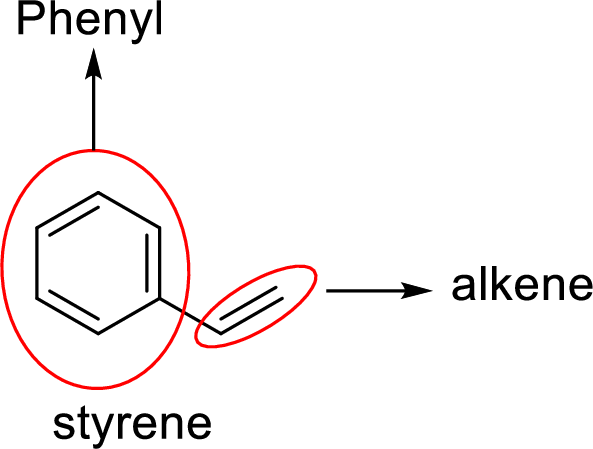
Analyzing the given structure for given styrene compound clearly shows that it contains one phenyl group since one
(b)
Interpretation:
The functional groups present in ethylene glycol have to be identified.
Concept Introduction:
Functional group: They are certain substitutes in the organic molecules which determine the characteristic reactions taking place in it.
There are different types of functional groups and it includes alkane, alcohol, aldehyde, amine, ether, carboxylic acid etc.
The entity formed as a result of bond formation between oxygen and hydrogen is called hydroxyl group. This is represented by
(b)
Explanation of Solution
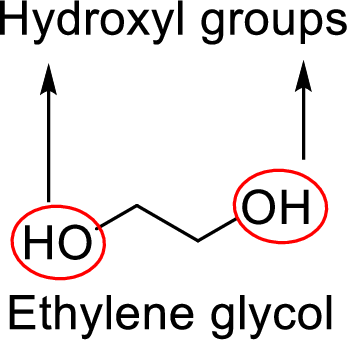
Analyzing the structure for given ethylene compound clearly shows that it contains two hydroxyl groups since hydroxyl group is entity formed by bond formation between oxygen and hydrogen atoms.
(c)
Interpretation:
The functional groups present in terephthalic acid have to be identified.
Concept Introduction:
Functional group: They are certain substitutes in the organic molecules which determine the characteristic reactions taking place in it.
There are different types of functional groups and it includes alkane, alcohol, aldehyde, amine, ether, carboxylic acid etc.
The cyclic group of atoms with formula
Alkenes: Alkenes are one of the important types of hydrocarbon which have at least one carbon-carbon double bond (
The functional group carboxylic acid is one which contains one hydroxyl group gets bonded with one carbonyl group that is one
The entity formed as a result of bond formation between oxygen and hydrogen is called hydroxyl group. This is represented by
(c)
Explanation of Solution
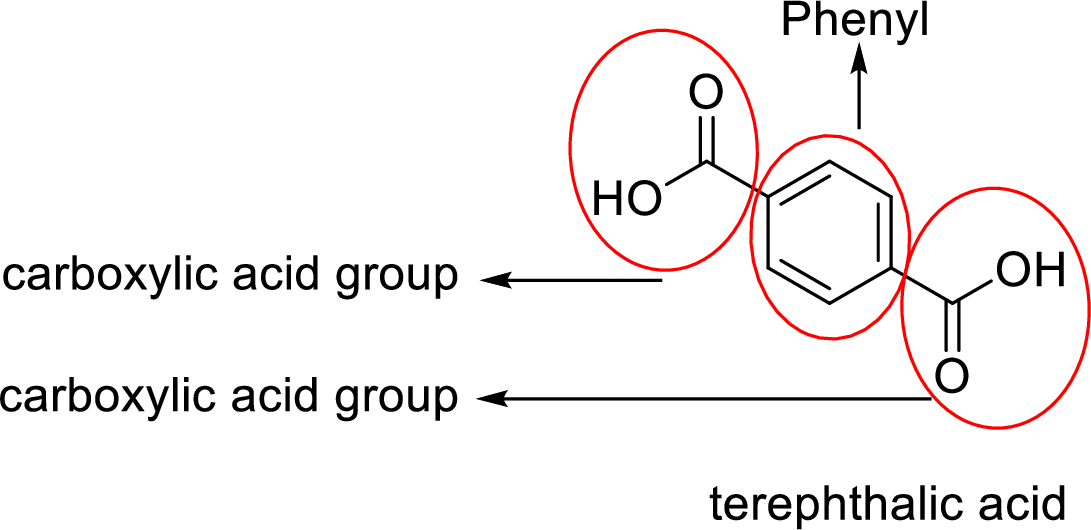
Analyzing the given structure for given terephthalic acid compound clearly shows that it contains one phenyl group since one
(d)
Interpretation:
The functional groups present in the amino acid in which
Concept Introduction:
Functional group: They are certain substitutes in the organic molecules which determine the characteristic reactions taking place in it.
There are different types of functional groups and it includes alkane, alcohol, aldehyde, amine, ether, carboxylic acid etc.
The functional group carboxylic acid is one which contains one hydroxyl group gets bonded with one carbonyl group that is one
The entity formed as a result of bond formation between oxygen and hydrogen is called hydroxyl group. This is represented by
Carboxylic acid: One
Amines are the derivatives of ammonia
(d)
Explanation of Solution
Amino acid had both amino functional group and carboxyl functional group in a molecule.
Amino functional group is
(e)
Interpretation:
The functional groups present in hexamethylenediamine have to be identified.
Concept Introduction:
Functional group: They are certain substitutes in the organic molecules which determine the characteristic reactions taking place in it.
There are different types of functional groups and it includes alkane, alcohol, aldehyde, amine, ether, carboxylic acid etc.
Amines are the derivatives of ammonia
Depending on the number of carbon side chain of the nitrogen, different types of amines can form.

(e)
Explanation of Solution
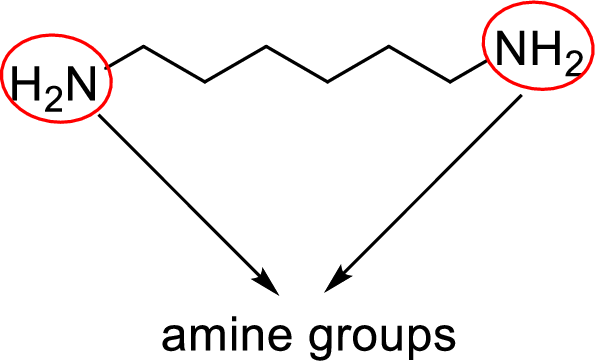
Analyzing the given structure for given hexamethylenediamine compound clearly shows that it contains two
(f)
Interpretation:
The functional groups present in adipic acid have to be identified.
Concept Introduction:
Functional group: They are certain substitutes in the organic molecules which determine the characteristic reactions taking place in it.
There are different types of functional groups and it includes alkane, alcohol, aldehyde, amine, ether, carboxylic acid etc.
Carboxylic acid: One
The functional group carboxylic acid is one which contains one hydroxyl group gets bonded with one carbonyl group that is one
The entity formed as a result of bond formation between oxygen and hydrogen is called hydroxyl group. This is represented by
(f)
Explanation of Solution
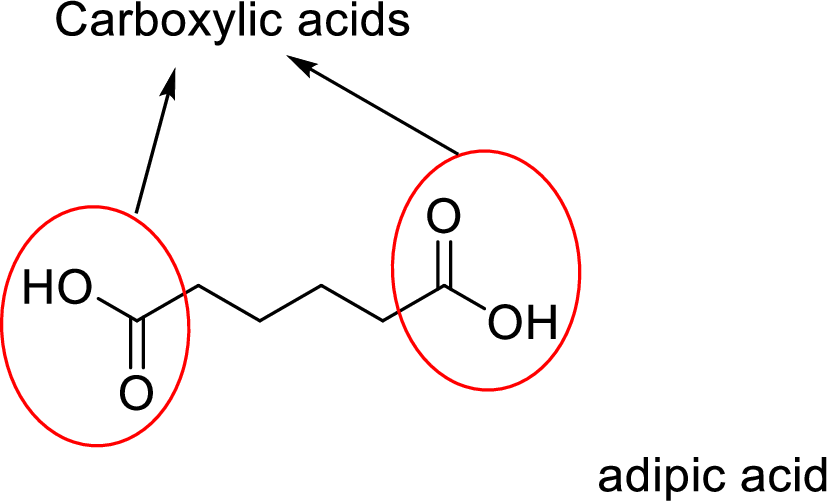
Analyzing the structure for given adipic acid compound clearly shows that it contains two carboxylic acids since carboxylic acid entity is one which contains one hydroxyl group gets bonded with carbonyl group.
Want to see more full solutions like this?
Chapter 9 Solutions
Chemistry In Context
- Write all of Me Possible Products For each Of the Following reactions. In each case identity all pains of enantiomers, all digsterzoners and all Meso compounds 9. 11-60 11-0-11 V-G Η Η H ~ C-11 +HB+ - 1 H b. पन्ना 171-0-11 H-C-H Н C-C=c-call +HBr Perendez ==arrow_forwardHow can i draw the mechanisms for this molecule?arrow_forwarda. Discuss and explain he difference IN Stability between the Chai and Boat Гольцу от судомехане b. For the Following Molecule draw both possible Clain conformations and explain which one is more stable and for what Reason. H. CH₂ CH₂ H "Harrow_forward
- Please provide the mechanism for this reacitonarrow_forwardQuestion 5: Name the following compound in two ways using side chain and using prefix amine (Common name and IUPAC name both) CH3NH2 CH3CH2NHCH3 CH₂CH₂N(CH3)2 Draw the structure of diethyl methyl amine Question 6. Write the balanced combustion reaction for: a. Hexane b. Propyne c. 2-pentene Question 7: Write the following electrophilic substitution reactions of benzene: Hint: Use notes if you get confused a. Halogenation reaction: b. Nitration reaction : c. Sulphonation reaction: d. Alkylation reaction: e. Aceylation reaction:arrow_forwardQuestion 4. Name the following structures ○ CH3-C-N-H H CH3CH2-C-N-H H CH3CH2-C-N-CH3 Harrow_forward
 ChemistryChemistryISBN:9781305957404Author:Steven S. Zumdahl, Susan A. Zumdahl, Donald J. DeCostePublisher:Cengage Learning
ChemistryChemistryISBN:9781305957404Author:Steven S. Zumdahl, Susan A. Zumdahl, Donald J. DeCostePublisher:Cengage Learning Chemistry: An Atoms First ApproachChemistryISBN:9781305079243Author:Steven S. Zumdahl, Susan A. ZumdahlPublisher:Cengage Learning
Chemistry: An Atoms First ApproachChemistryISBN:9781305079243Author:Steven S. Zumdahl, Susan A. ZumdahlPublisher:Cengage Learning
 World of Chemistry, 3rd editionChemistryISBN:9781133109655Author:Steven S. Zumdahl, Susan L. Zumdahl, Donald J. DeCostePublisher:Brooks / Cole / Cengage LearningChemistry: Matter and ChangeChemistryISBN:9780078746376Author:Dinah Zike, Laurel Dingrando, Nicholas Hainen, Cheryl WistromPublisher:Glencoe/McGraw-Hill School Pub Co
World of Chemistry, 3rd editionChemistryISBN:9781133109655Author:Steven S. Zumdahl, Susan L. Zumdahl, Donald J. DeCostePublisher:Brooks / Cole / Cengage LearningChemistry: Matter and ChangeChemistryISBN:9780078746376Author:Dinah Zike, Laurel Dingrando, Nicholas Hainen, Cheryl WistromPublisher:Glencoe/McGraw-Hill School Pub Co Introductory Chemistry: An Active Learning Approa...ChemistryISBN:9781305079250Author:Mark S. Cracolice, Ed PetersPublisher:Cengage Learning
Introductory Chemistry: An Active Learning Approa...ChemistryISBN:9781305079250Author:Mark S. Cracolice, Ed PetersPublisher:Cengage Learning





